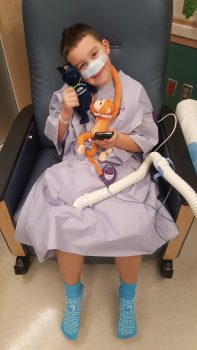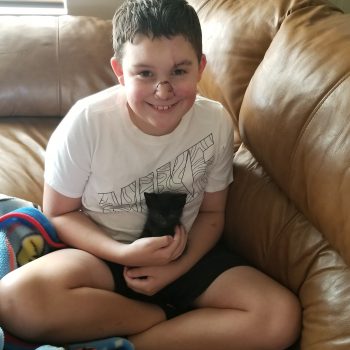
For most of the past year, 9-year-old Tristan Beck has been on a long, challenging journey toward nose reconstruction after a traumatic accident left him with a missing nose.
December 20, 2017 was a normal day of winter break for the Beck family. Tristan and his older sister were visiting their mother’s office to drop off food for a party. When they returned to the car, a dog was in the parking lot, showing no signs of aggression. However, when Tristan began to throw the dog a piece of food, it lunged at Tristan’s face and pulled him down. Tristan’s sister pulled him back, and the dog ran away.
All Tina Beck, Tristan’s mother, remembers is the blood on his face when his sister brought him back into her office.
“There was so much blood it was hard to see exactly what was wrong,” said Beck. “It was very hard for me to look at my son at first. My heart hurt and I was blaming myself for what had happened, but I wanted to be strong for him.”
The family called 911, and Tristan was transported to Seattle Children’s Emergency Department.
A major change
Dr. Raymond Tse, a surgeon with Seattle Children’s Plastic Surgery team and Craniofacial Center, put Tristan under anesthesia to clean the wound and determine the extent of his injuries.
The Beck family was devastated to learn that Tristan’s injuries did not have a quick or simple fix. Tristan’s nose and part of his cheek were missing.
“Seattle Children’s is one of the few places that can provide this kind of specialized care to reconstruct a nose from scratch,” said Tse. “Part of that stems from our strength as a Craniofacial Center that’s engaged day to day in complex facial reconstruction.”
That evening, Tristan underwent the first of five surgeries he would need to reconstruct his nose.
“Dr. Tse was very calm and patient with us while our emotions were on a rollercoaster,” said Beck. “While most of that day was a blur, what stood out was every staff member we came in contact with. They offered their support, whether it was a cup of water, box of Kleenex or just a quiet minute outside the hospital room to shed a tear and catch your breath.”
Tse, who performs nose reconstructive surgeries for children with cleft lip and palate, said seeing Tristan after his accident highlighted the importance of the nose to one’s face and self-image. Tse hoped to help the family adjust to the major change in his appearance before Tristan began the lengthy process of rebuilding his nose.
“The nose is the centerpiece of the face that in many ways defines our appearance and who we are,” said Tse. “We made sure Tristan’s wound could heal in the short term, but part of his long term healing would also involve him becoming comfortable with his altered face – something that would understandably take time after a traumatic event like that.”
Healing
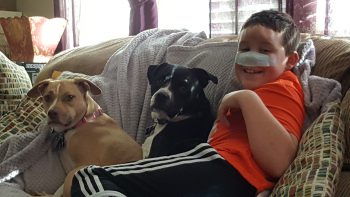
Once the family returned home, Beck was surprised that after a day of resting, Tristan asked to see the family’s two dogs, who live with Tristan’s sister and were home for the holiday.
“That kind of broke our hearts,” said Beck. “Even with all that he has gone through, he still loves dogs.”
Seattle Children’s sees many dog bite injuries, particularly with unsupervised younger children. Tristan’s situation was unpredictable and less preventable since he was not irritating the dog, according to Tse.
“The hospital sees many kids with dog bite injuries on a weekly basis,” said Tse. “Several times per year these require major surgical reconstruction.”
First step in a long process
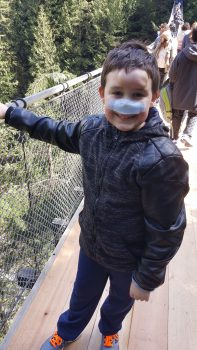
Because forehead skin matches the skin on the nose, it is often used for nose reconstructions. However, Tristan’s forehead did not have enough skin to create a nose.
On Feb. 16, 2018, Tristan’s care team inserted a tissue expander, similar to a balloon, under his forehead skin. The expander was injected with saline during weekly visits. Over the next few months, the expander inflated, slowly stretching Tristan’s forehead and creating more skin to use.
Though it was not medically necessary, Tristan chose to wear a bandage over the mid-part of his face to cover his injuries. Because of the prominent bulge resulting from the forehead expander, he also wore a hat anytime he left the house because of the questions people would ask him about his face, said Beck.
Daily activities, like participating in gym class or taking a shower, were uncomfortable.
“During all of this, my son was a trooper,” said Beck. “Some nights he was quiet and distant, and he opened up to his sister about being teased by a couple of older kids. Luckily, most of the kids at school were very protective of him, and nipped the bullying incidents in the bud.”
Rebuilding a nose
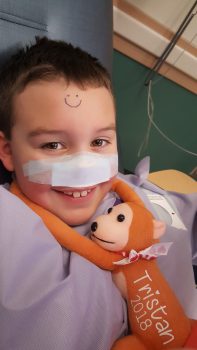
Next, the team moved forward with a standard three-stage nose reconstruction.
In the first stage of reconstruction surgery on Aug. 3, 2018, Tse’s team used some of Tristan’s scar and the skin left on his nose to create his nose’s inner lining, since the nose has different layers. Tristan’s rib cartilage was used to create the structure of the nose so that it had a shape, though it was not yet in the shape of a nose. Then, the team used Tristan’s expanded forehead skin to create the surface of the nose. They hinged the forehead skin to the nose with a bridge of skin that contained an artery and a vein, creating blood supply. All the tissues and materials for his new nose were in place.
“After Tristan’s first surgery, I was overwhelmed and exhausted but amazed by everything Children’s had to keep parents comfortable and sane,” said Beck. “We are so blessed to be in area where we are close to Children’s.”
About one month later, surgeons did an intermediate stage of surgery. They lifted up the forehead flap to further contour the lining, tissues, cartilage and skin. Doctors sculpted the skin, creating the shape of a nose on the lower part of the nose, and replaced Tristan’s forehead flap.
Tristan’s fifth surgery and final stage in the reconstruction was on Sept. 28, 2018. Doctors lifted up Tristan’s forehead skin again and contoured the upper part of the nose. They also divided the connection between the forehead and his nose. By then, Tristan had good blood supply from the healed area of his lower nose.
Throughout the experience, the Becks had support from friends and family, including Tristan’s grandmother, aunt and sister.
Transformative impact
During his last three surgeries, Beck noticed changes in Tristan. He became more open to seeing friends and started removing the bandage over his nose when he would go out in public. After each surgery, it generally took Tristan one or two weeks to look in the mirror. However, after the last surgery, he looked in the mirror three days after coming home.
“He’s been through a lot more than I would have ever expected my son to go through at age 9,” said Beck. “It’s shocking to me how strong he’s been. He doesn’t get upset or blame the dog for anything.”
Tse also observed how the reconstruction had transformed Tristan during their frequent clinic appointments.
“I’ve seen Tristan gain more and more confidence over the course of his reconstruction,” said Tse. “We’ve taken Tristan step by step through a process where he’s seen changes, improvements and the value in what we are doing. At first, he wouldn’t talk to anyone or smile. Then, he came to clinic without slouching. He later showed up talking and joking. Now, he’s loosened up to the point where his personality is finally shining through. It’s been a journey for everyone; seeing him come to clinic with a smile instead of a mask over his face has been a reminder of why we do what we do.”
Thankful for that same smile
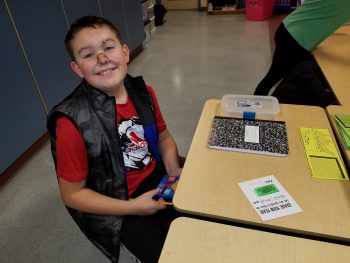
Although going to the hospital was often a scary experience for Tristan since it was associated with a traumatic event, Beck said Seattle Children’s doctors, nurses and Child Life program helped immensely.
“When something like this occurs, your mind goes blank and you don’t know how to react, but Seattle Children’s was fabulous,” said Beck. “Seeing the same nurses was great because they knew how Tristan reacts to needles. Child Life was at every appointment bringing an activity to keep Tristan calm. They even brought him gifts on his birthday.”
Tristan has one more surgery next year for further shaping and correcting, but he now has a nose again, making everyday occurrences – like being outdoors – easier.
Tristan said he is excited to get back to playing with his friends and for an upcoming family vacation to a Disney theme park. He remains an animal lover, and his favorite animal at the moment is a turtle. Now that his forehead is healed, he can wear a helmet and ride his bike again.
Beck said she is most thankful to see the return of her son’s “natural, true smile”– the smile she hadn’t seen in awhile.
“As a parent, you always want to make sure your child is protected, but we know that some things happen that are out of our control,” said Beck. “We can’t predict what will happen, but we can do our best to try to prevent it or handle the situation. I think this experience has made Tristan stronger, more compassionate and understanding of different types of people.”

